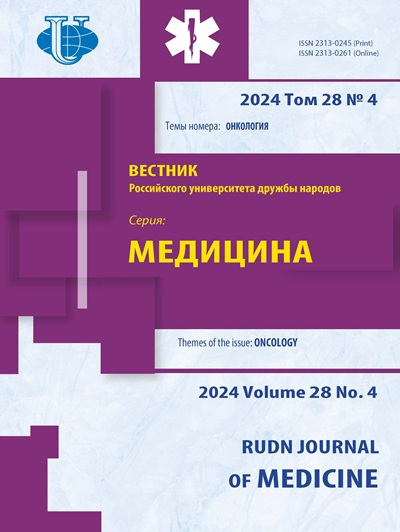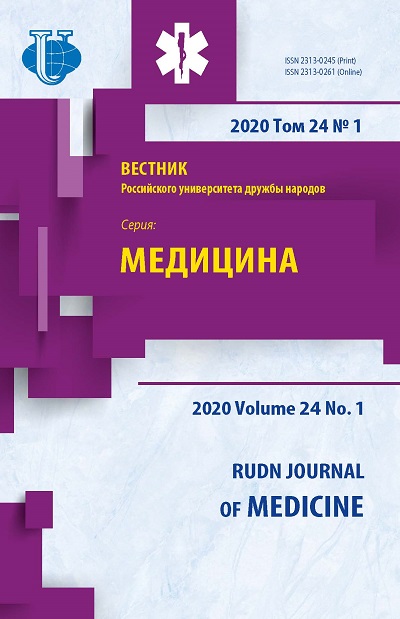Сравнительный анализ применения виртуальных и механических артикуляторов в функциональной диагностике
- Авторы: Чхиквадзе Т.В.1, Рощин Е.М.1, Бекреев В.В.1
-
Учреждения:
- Российский университет дружбы народов
- Выпуск: Том 24, № 1 (2020)
- Страницы: 38-51
- Раздел: Стоматология
- URL: https://journals.rudn.ru/medicine/article/view/23393
- DOI: https://doi.org/10.22363/2313-0245-2020-24-1-38-51
Цитировать
Полный текст
Аннотация
В работе представлены результаты обследования пациентов с нарушениями артикуляции нижней челюсти, вызванных внутренней патологией ВНЧС. Цель представленной работы - изучить эффективность применения механических и виртуальных артикуляторов в функциональной диагностике пациентов с внутренними нарушениями ВНЧС. Всем пациентам проводилось комплексное клиническое и инструментальное обследование, включавшее конусно-лучевую компьютерную томографию (КЛКТ) и аксиографическое исследование (оптический аксиограф Dentograf Prosystom, Россия). КЛКТ использовалось для оценки состояния ВНЧС и определения индивидуального соотношения моделей челюстей и суставов. При аксиографии регистрировали и анализировали суставные траектории движения нижней челюсти. В I группе пациентов динамическая окклюзия оценивалась с использованием механического артикулятора, во II группе применяли виртуальный артикулятор. Выявлено, что применение механических артикуляторов в функциональной диагностике для оценки динамической окклюзии ограничено и не позволяет получить индивидуализированные данные пациента, их эффективность составила 75%. Использование виртуальных артикуляторов позволяет оценить динамическую окклюзию при открывании-закрывании рта, протрузии и латеротрузии, а также непрерывном движении нижней челюсти с регистрацией всех возможных зубных контактов. Благодаря совмещению данных КТ головы пациента и виртуальных моделей была достигнута максимально высокая точность размещения моделей в виртуальном артикуляторе в соответствии с индивидуальными особенностями пациентов.
Об авторах
Т. В. Чхиквадзе
Российский университет дружбы народов
Автор, ответственный за переписку.
Email: tchkhik@hotmail.com
Москва, Российская Федерация
Е. М. Рощин
Российский университет дружбы народов
Email: tchkhik@hotmail.com
Москва, Российская Федерация
В. В. Бекреев
Российский университет дружбы народов
Email: tchkhik@hotmail.com
Москва, Российская Федерация
Список литературы
- Ohrbach R., Dworkin S.F. The evolution of TMD diagnosis past, present, future // Journal of Dental Research. 2016. v. 95. № 10. P. 1093—1101.
- Гулуев А.В. Методы диагностики заболеваний ВНЧС // Medical Sciences. 2017. № 2. С. 14—18.
- Гажва С.И., Зызов Д.М., Болотнова Т.В., Сенина-Волжская И.В., Демин Я.Д., Аствацатрян Л.Э., Котунова Н.А., Тимофеева Е.И. Сравнение дополнительных методов диагностики дисфункции височно-нижнечелюстного сустава // Медицинские науки. 2017. Т. 55. № 1, 98—101.
- Becker Villamil M., Garcia E. Virtual articulator – aid simulator at diagnosis, pre-Surgical planning and monitoring of bucomaxilofacial treatment // 50th Hawaii International Conference on System Sciences 2017. P. 3506—3515.
- Prafulla Tumati. Diagnostic tests for temporomandibular disorders // Journal of Advanced Clinical & Research Insights. 2016. № 3., P. 81—86.
- Силин А.В., Ицкович И.Э., Бутова А.В. Магнитно-резонансная томография в комплексном обследовании жевательных мышц и мониторинге результатов лечения мышечно-суставной дисфункции височно-нижнечелюстных суставов // Ортодонтия. 2018. № 3. С. 18—24.
- Дорогин В.Е. Междисциплинарный подход к диагностике, лечению, и реабилитации пациентов с дисфункцией височно-нижнечелюстного сустава // Современные проблемы науки и образования. 2017. № 4.
- Антонник М.М. Возможности и перспективы современных компьютеризированных систем для диагностики и терапии окклюзионных нарушений // Цифровая стоматология. 2014. № 9. С. 2—8.
- Luthra R.P., Gupta R., Kumar N., Mehta S., Sirohi R. Virtual articulators in prosthetic dentistry // Journal of Advanced Medical and Dental Sciences Research. 2015.V. 3. № 4. P. 117—121.
- Хорев О.Ю., Майборода Ю.Н. Окклюзионные интерференции и нейромышечная дисфункция // Кубанский научный медицинский вестник. 2017. Т. 24. № 6. С. 161—167.
- De Kanter R.J.A.M., Battistuzzi P.G.F.C.M., Truin G.-J. Temporomandibular disorders: “occlusion” matters! // Pain Research and Management. 2018, Article ID8746858, 13 P.
- Ferreira L.A., Grossmanne E., Januzzih E., Quiroz de Paula M.V., Pires Carvalho A.C. Diagnosis of temporomandibular joint disorders: indication of imaging exams // Braz J Otorhinolaryngol. 2016. V. 82. № 3. P. 341—352.
- Бутова А.В., Ицкович, Силин А.В., Синицина Т.М., Малецкий Э.Ю., Кахели М.А. Магнитно-резонансная томография в диагностике патологии жевательных мышц при мышечно-суставной дисфункции височно-нижнечелюстных суставов // Вестник Северо-Западного государственного медицинского университета им. И.И. Мечникова. 2016. Т. 8. № 3. С. 13—18.
- Suenaga S., Nagayama K., Nagasawa T., Indo H., Majim H.J. The usefulness of diagnostic imaging for the assessment of pain symptoms in temporomandibular disorders // Japanese Dental Science Review. 2016. V. 52. P. 93—106.
- Costantinides F., Parisi S., Tonni I., Bodin Ch., Vettori E., Perinetti Giuseppe, Di Lenarda R. Reliability of kinesiography vs magnetic resonance in internal derangement of TMJ diagnosis // The Journal of Craniomandibular & Sleep Practice. http://www.tandfonline.com/loi/ycra20
- Schnabla D., Rottlerb A.K., Schuppb W., Boisser W., Grunert I. CBCT and MRT imaging inpatients clinically diagnosed with temporomandibular joint arthralgia // Heliyon 4 (2018) e00641.doi: 10.1016/j.heliyon.2018. e0064. http://creativecommons.org/licenses/by-nc-nd/4.0/).
- Sójka A., Hubeк J., Kaczmarek E., Hędzelek W. Ascertaining of temporomandibular disorders (TMD) with clinical and instrumental methods in the group of young adults // Journal of Medical Science. 2015. V. 84. P. 20—26.
- Арутюнов С.Д., Брутян Л.А., Антоник М.М., Лобанова Е.Е. Особенности корреляции показателей электромиографического и аксиографического исследований у пациентов с повышенным стиранием твердых тканей зубов // Российский стоматологический журнал. 2017. T. 21. № 5. C. 244—247.
- Kumar Koralakunte P.R., Aljanakh M. The role of virtual articulator in prosthetic and restorative dentistry // Journal of Clinical and Diagnostic Research. 2014. V. 8. № 7. P. 25—28.
- Valencia Jairo L.R., Tamayo-Muñoz M.C., Ruiz-Rubiano C., Ramos L., Ayala R., Solaberrieta E. Evaluación de un articulador virtual para la identificación de interferencias en movimientos mandibulares excéntricos // XXXV Congreso Anual de la Sociedad Española de Ingenieria Biomedica. Bilbao. 2017. P. 327—330.
- Nishi S.E., Basri R., Khursheed Alam M. Uses of electromyography in dentistry: An overview with metaanalysis // J Dent. 2016. V.10. № 3. P. 419—425.
- Kwang-Ho Choia, O Sang Kwona, Ui Min Jernga, So Min Lee, Lak-Hyung Kimb, Jeeyoun Jun. Development of electromyographic indicators for thediagnosis o ftemporomandibular disorders: a protocol for an assessorblindedcross-sectional study // Jun. Integr Med. Res. 2017. № 6. P. 97—104.
- Klatkiewicz T., Gawriołek K., Radzikowska M.P., CzajkaJakubowska A. Ultrasonography in the diagnosis of temporomandibular disorders: a meta-analysis // Med Sci Monit. 2018. V. 24. P. 812—817.
- Хватова В.А. Клиническая гнатология. М: Медицина, 2005. 296 с.
- Haralur S.B. Digital evaluation of functional occlusion parameters and their association with temperomandibular disorder // Journal of Clinical and Diagnostic Research. 2013. V. 7. № 8. P. 1772—1775.
- Gözler S. JVA, mastication and digital occlusal analysis in diagnosis and treatment of temporomandibular disorders // http://dx.doi.org/10.5772/intechopen.72528. P. 128—159.
- Митин Н.Е., Набатчикова Л.П., Васильева Т.А. Анализ современных методов оценки и регистрации окклюзии зубов на этап стоматологического лечения // Российский медико-биологический вестник имени академика И.П. Павлова. 2015. № 3. С. 134—139.
- Pateln M., Alani A. Clinical issues in occlusion–Part II // Singapore Dental Journal. 2015. V. 36. P. 2—11.
- Padmaja B.I., Madan B, Himabindu G, Manasa C. Virtual articulators in dentistry // International Journal of Medical and Applied Sciences. 2015. V. 4. 2. P. 109—114.
- Úry E., Fornai C., Weber G.W. Accuracy of transferring analog dental casts to a virtual articulator. // The Journal of Prostetic Dentistry. https://doi.org/10.1016/j.prosdent. 2018.12.019
















